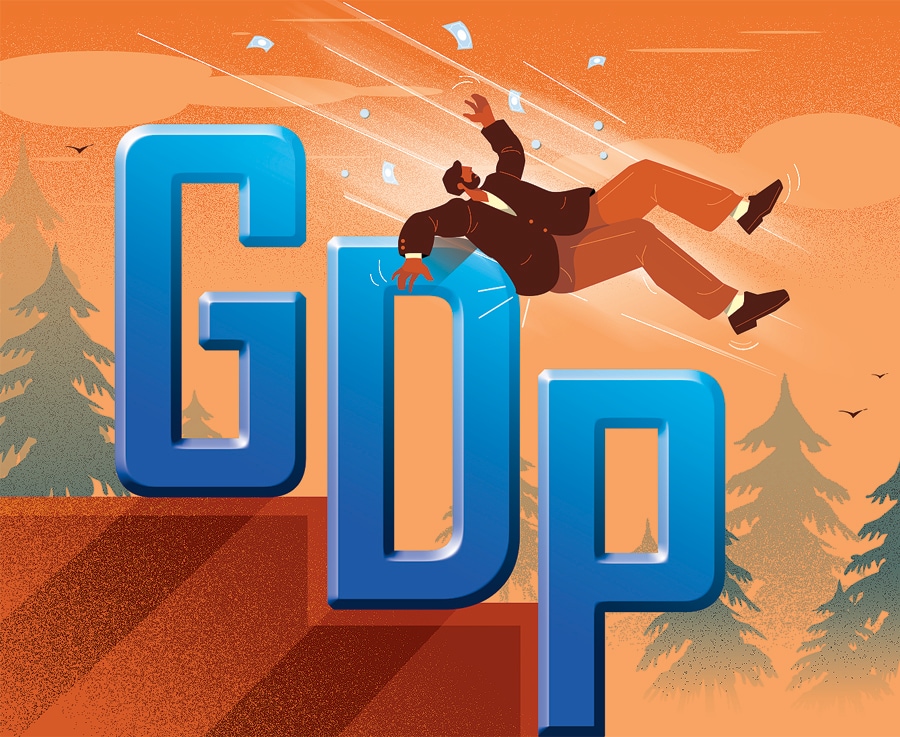
Decoding India's broad-based growth collapse
By Samar Srivastava| Sep 11, 2020
India's dismal first quarter performance has resulted in full year estimates being revised downwards
 Illustration: Chaitanya Dinesh Surpur [br]
Illustration: Chaitanya Dinesh Surpur [br]As GDP numbers in the first quarter came in, it became apparent that Indians had obeyed the stringent lockdown and curtailed economic activity. Growth had contracted 23.9 percent—worst among the G-20 group of nations—for the June-ended quarter.
Now as economic activity has resumed along with an increasing rate of infection spread, economists have revised their full-year projections downwards. The projections that were in the -5 to -7.5 percent range have moved to -9 to -14 percent for the full year. Ratings agency ICRA expects GDP to contract -9.5 percent. The State Bank of India expects a contraction of -10.9 percent compared to -6.8 percent previously and Pronab Sen, former chief statistician, says the number could go up to -14 percent.
_RSS_At 3.1 percent, growth for the March-ended quarter was the worst in eight years. With inflation numbers for April and May still tentative on account of insufficient data, it is likely that the GDP deflator would be revised, resulting in growth numbers moving further downwards.
The biggest declines were seen in manufacturing (39.3 percent), construction (50.3 percent) and trade (47 percent), according to the National Statistical Office. Core sector numbers for July showed a decline of 9.6 percent pointing to continued weakness in manufacturing activity. GST collections in August at ₹86,449 crore were down by 12 percent from the same period last year.
“The recovery looks more measured than what we anticipated three months ago,” says Rahul Bajoria, chief India economist, Barclays.
Agriculture registered a growth of 3.4 percent as the lockdown excluded activities related to farming and allied activities. In its June 2020 Global Economic Outlook, the World Bank said it would take time for developing countries to get back to their pre-Covid rates of economic output.
The weak data is likely to further calls for a fiscal stimulus to an economy that was reeling from a slowdown before the pandemic. So far, the government has been careful in loosening its purse strings. Most of the ₹20,00,000 crore stimulus was in the form of loan guarantees. It has, however, hinted that once the pandemic is under control, it could come up with a further stimulus.
For now, economists are watching leading indicators to see if a recovery in July and August was due to pent-up demand. Tractor, two-wheeler sales and consumer goods sold in rural areas have done well. Area under kharif sowing is up by 19 percent. With a good monsoon it is likely that rural growth continues. Investment demand has been comatose, resulting in 5.5 percent increase in bank credit growth in the fortnight ended August 14. With an end to the moratorium in August, it remains to be seen where bank NPAs settle. This would have a direct correlation to their ability to lend.
Most worrying has been the decline in private consumption spending, which fell by 54.3 percent in the first quarter. With consumption spending accounting for 57 percent of growth, it remains to be seen whether catch-up spending can pick up the slack in the next three quarters.
Sameer Narang, chief economist at Bank of Baroda, says with incomes under stress, consumers will use existing assets longer. He points to the US where the average age of a car has increased from seven to 12 years in the last decade. A decline in consumption without a pick-up in government spending, exports or investment would result in a double-digit hit to full year growth, says Narang.